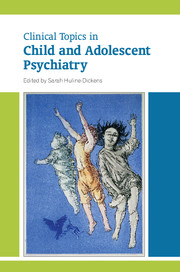Book contents
- Frontmatter
- Contents
- List of tables
- List of boxes
- List of figures
- List of contributors
- Preface
- 1 Child psychiatry and the people who have shaped it
- 2 Fabrication and induction of illness in children
- 3 Personality disorders as disorganisation of attachment and affect regulation
- 4 Post-traumatic stress disorder and attachment: possible links with borderline personality disorder
- 5 Management of antisocial behaviour in childhood
- 6 Pharmacology for attention-deficit hyperactivity disorder, Tourette syndrome and autism spectrum disorder
- 7 Pharmacology for anxiety and obsessive–compulsive disorders, affective disorders and schizophrenia
- 8 Pharmacological management of core and comorbid symptoms in autism spectrum disorder
- 9 Pharmacological treatment of depression and bipolar disorder
- 10 Cognitive–behavioural therapy with children, young people and families: from individual to systemic therapy
- 11 Anxiety disorders
- 12 Somatising: clinical presentations and aetiological factors
- 13 Somatising: management and outcomes
- 14 Evaluating psychological treatments for children with autism
- 15 Attention-deficit hyperactivity disorder: assessment and treatment
- 16 Schizophrenia
- 17 Tourette syndrome
- 18 Sleep disorders
- 19 Self-harm in adolescents
- 20 Adolescent substance misuse: an update on behaviours and treatments
- 21 Eating disorders
- 22 Gender dysphoria in young people
- 23 The psychiatry of children aged 0–4
- Index
7 - Pharmacology for anxiety and obsessive–compulsive disorders, affective disorders and schizophrenia
Published online by Cambridge University Press: 02 January 2018
- Frontmatter
- Contents
- List of tables
- List of boxes
- List of figures
- List of contributors
- Preface
- 1 Child psychiatry and the people who have shaped it
- 2 Fabrication and induction of illness in children
- 3 Personality disorders as disorganisation of attachment and affect regulation
- 4 Post-traumatic stress disorder and attachment: possible links with borderline personality disorder
- 5 Management of antisocial behaviour in childhood
- 6 Pharmacology for attention-deficit hyperactivity disorder, Tourette syndrome and autism spectrum disorder
- 7 Pharmacology for anxiety and obsessive–compulsive disorders, affective disorders and schizophrenia
- 8 Pharmacological management of core and comorbid symptoms in autism spectrum disorder
- 9 Pharmacological treatment of depression and bipolar disorder
- 10 Cognitive–behavioural therapy with children, young people and families: from individual to systemic therapy
- 11 Anxiety disorders
- 12 Somatising: clinical presentations and aetiological factors
- 13 Somatising: management and outcomes
- 14 Evaluating psychological treatments for children with autism
- 15 Attention-deficit hyperactivity disorder: assessment and treatment
- 16 Schizophrenia
- 17 Tourette syndrome
- 18 Sleep disorders
- 19 Self-harm in adolescents
- 20 Adolescent substance misuse: an update on behaviours and treatments
- 21 Eating disorders
- 22 Gender dysphoria in young people
- 23 The psychiatry of children aged 0–4
- Index
Summary
This chapter has been written as a companion to Chapter 6. Here we focus on current pharmacological approaches to the treatment of anxiety disorders, obsessive–compulsive disorder, affective disorders and schizophrenia in children and adolescents.
Anxiety disorders
Despite being the most common psychiatric illness in childhood and adolescence, affecting somewhere between 5 and 18% of young people, early-onset anxiety disorders remain poorly understood. They can, however, cause serious disruption to children's lives and are often persistent over time, leading to increased risks of continued anxiety disorders in adulthood as well as major depression, substance misuse and educational underachievement. The use of medication to manage child and adolescent anxiety disorders remains contentious, with many clinicians arguing that these disorders are always most appropriately treated with psychosocial interventions. However, as success rates for cognitive and behavioural interventions fall in the range of 70–80%, significant numbers of children require further treatments.
Benzodiazepines and tricyclic antidepressants
The first drugs to be studied in the treatment of child and adolescent anxiety were benzodiazepines and tricyclic antidepressants. Benzodiazepines should be considered only when other pharmacological approaches have failed, and they should be prescribed for weeks rather than months. Dose adjustments should be made gradually, both when starting and when tapering off treatment (Velosa & Riddle, 2000). There have been several randomised controlled trials (RCTs) of tricyclic antidepressants in the treatment of paediatric anxiety. Unfortunately, the positive results from initial studies have not been sustained (Velosa & Riddle, 2000) and tricyclics should not be considered as first-line treatments for anxiety disorders in this age group. Several open-label studies have shown buspirone, a non-benzodiazepine anxiolytic reported effective in adults, to be comparable in efficacy to the benzodiazepines, with fewer adverse events, in childhood anxiety disorders. However, no controlled data are available for either safety or efficacy.
Selective serotonin reuptake inhibitors
The selective serotonin reuptake inhibitors (SSRIs) are now the first-choice pharmacological treatment for child and adolescent anxiety disorders. As in depression (see below), their use increased before firm data on their efficacy were available. However, there are now RCT data for fluvoxamine, fluoxetine, sertraline, paroxetine and venlafaxine.
- Type
- Chapter
- Information
- Clinical Topics in Child and Adolescent Psychiatry , pp. 94 - 111Publisher: Royal College of PsychiatristsPrint publication year: 2014

